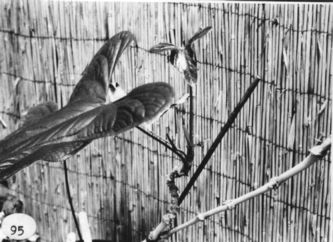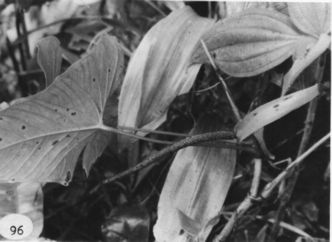Anthurium hutchisonii Croat, sp. nov.
TYPE: Panama. Panama: Cerro Campana, Middle slopes, ca. 650 m, Croat 35968 (MO 2389018, holotype; F, K, PMA, US, isotypes; Live at MO).
Anthurium hutchisonii Croat, sp. nov.
TYPE: Panama. Panama: Cerro Campana, Middle slopes, ca. 650 m, Croat 35968 (MO 2389018, holotype; F, K, PMA, US, isotypes; Live at MO).
Planta epiphytica aut terrestris, caudex 1 m longus aut longiore, internodia, 3-7 cm longa; cataphyllum subcoriaceum, persistens circum caudex ad nodos superos; petiolus teres ad leviter camplanatus adaxiale, 13÷40 cm longus; lamina ovato ad ovato-triangulata, modice membranacea, basi late ad profunde cordata, 16-46 cm longa, 9.5-28 cm lata; inflorescentia effusa, pedunculus teres, 9.5-20 cm longus; spatha subcoriacea, pallide viridis, linearis-lanceolata, 6-12 cm longa, 0.8-1.5 cm lata; spadix flavovirens, lutescens, 6.3-14 cm longus; baccae rubrae, ellipsoideae ad ovoideae.
Epiphytic or terrestrial from near the ground; stems 1 m or more long, 0.8-1.3 cm diam., the epidermis tan (closest to B & K Yellow-red 9/5), glossy; internodes 3-7 cm long; leaf scars ca. 1 cm wide; roots elongate, slender, descending; cataphylls subcoriaceous, 7-16 cm long, apiculate at apex, drying tan to light brown, persisting around stem at upper nodes, deciduous in lower portion of stem.
LEAVES spreading, usually at apex of stem; petioles terete to weakly flattened adaxially, 13-40 cm long, 3-6 mm diam.; geniculum 1-3 cm long, weakly sulcate; blades ovate to ovate-triangular, moderately thin, long-acuminate at apex, broadly to deeply lobed at base, 16-46 cm long, 9.5-28 cm wide, broadest near the base; anterior lobes 4.5-38 cm long, the margins straight to convex or concave; posterior lobes 4-13 cm (from apex of sinus to outermost tip of lobe); sinus arcuate to parabolic to hippocrepiform, rounded at apex; the surface matte, usually drying conspicuously blackened, midrib acutely raised above, diminished and sunken toward apex, convexly raised below; basal veins 5-7 pairs, the first, sometimes second free, the remainder coalesced 0.7-3 cm, raised on both surfaces; posterior ribs naked, weakly turned up on outer margins; primary lateral veins 5-8 per side, departing the midrib at a 35-45° angle, usually straight, sometimes weakly arched to collective vein, sunken above, raised below; interprimary veins sunken above, prominulous below; secondary veins visible, flat; collective vein arising from one of the lowermost basal veins, loop-connecting with the basal and primary lateral veins, 4-9 mm from the margin, all veins drying darker than surface.
INFLORESCENCE spreading; peduncles terete, 9.5-20 cm long, 3-5 mm diam.: spathe subcoriaceous, pale green (B & K Yellow-green 7/10), linear-lanceolate, 6-12 cm long, 0.8-1.5 cm wide, broadest just above base, cuspidate at apex, rounded to subcordate at base, inserted on the peduncle at ca. 30° angle; stipe ca. 3 mm long; spadix yellow-green turning yellow, weakly tapered toward apex, 6.3-14 cm long, 5-11 mm diam. at base, 4-8 mm diam. at apex; flowers 4-lobed (1.8-)2.2-2.7 mm long, (1.8-)2-2.4 mm wide, the sides jaggedly sigmoid, ca. 6 flowers visible in the principal spiral, 8-10 flowers visible in the alternate spiral; tepals semiglossy, minutely and inconspicuously punctate, lateral tepals (0.7-) 1-1.2 mm wide, the inner margin turned up against pistil; pistils scarcely emergent, green, same color as tepals; stigmas scarcely visible; stamens emerging from the base, lateral stamens emerging from base to apex, followed quickly by alternates; anthers white, 0.3-0.5 mm in both directions, held over pistil; thecae ellipsoid, tan; pollen creamy white.
INFRUCTESCENCE with berries red, ellipsoid to ovoid, rounded at apex, 5-6.5 mm long, 3-4 mm diam., the mesocarp with linear to punctiform raphide cells in the apical half; seeds 2, broadly ellipsoid, rounded at both ends, 1.7-3 mm long, 2.2-2.5 mm wide, 1.1-1.3 mm thick, the appendage enveloping all of one side of seed and extending to ca. 1 mm beyond the seed on the apical end. Figs. 95and 96.
Anthurium hutchisonii is known from Panama but is expected also in Colombia. It ranges from Chiriquí to Darien at 500 to 1,400 m in premontane rain forest.
The species is doubtfully placed in section Xialophyllium. It is recognized by its elongate, glossy, tan stems with generally long internodes, its broadly to deeply lobed, ovate to ovate-triangular blades that usually dry conspicuously blackened, and by its short-pedunculate inflorescence with a green, lanceolate spathe, a greenish yellow to yellow, tapered spadix, and red berries. Blade shape is variable with the margin varying from convex to concave.
The species is named in honor of Mr. Paul C. Hutchison (collecting for the University of California) who, along with Bob Dressier, made the first collection of the species in 1963. It is most easily confused with Anthurium leptocaule, which has a similar habit with elongate internodes and similar leaf blades. The latter diners, however, in having leaves that dry brown and a spadix that is creamy white rather than yellowish at anthesis.
 |
 |
Map of Mesoamerican specimens with coordinates
Panama Bocas del Toro: 590 m, 8.46N 82.14W, 10 March 1985, T.B. Croat
& M.H. Grayum 60184 (MO).
Panama Bocas del Toro: 1200 m, 08.45N 82.15W, 16 April 1987, Gordon
McPherson 10863 (MO).
Panama Bocas del Toro: 650 m, 8.47N 82.11W, 22 Sept. 1984, H.W. Churchill
& A. Churchill 6205 (MO).
Panama Bocas del Toro: 950 m, 8.47N 82.12W, 22 Sept. 1984, H.W. Churchill
& A. Churchill 6248 (MO).
Panama Bocas del Toro:, 25 June 1986, W.G. D'Arcy 16412 (MO).
Panama Chiriquí: 1200-1500 m, 8.47N 82.13W, 25 May 1984, H.W. Churchill
5300 (MO).
Panama Chiriquí: 08.44N 82.17W, 23 June 1994, Thomas B. Croat &
Guanghua Zhu 76320 (MEXU, MO, NY).
Panama Chiriquí:, 7 December 1997, D.W. Roubik & L. Quroz 1288
.
Panama CoclŽ: 800 m, 08.39N 80.36W, 31 March 1993, Thomas B. Croat
75072 (MO).
Panama CoclŽ: 900-1000 m, 8.37N 80.08W, 13 July 1987, Thomas B. Croat
67219 (MO).
Panama CoclŽ: 580-740 m, 8.38N 80.36W, 12 Sept. 1987, Thomas B. Croat
67521 (MO).
Panama Darien: 800 m, 7.58N 77.42W, 12 Aug 1986, McDonagh et al. 659
(BM).
Panama Darien: 550-760 m, 7.57N 77.46W, 28 June 1988, Thomas B. Croat
68864 (MO).
Panama Panamá: 800-900 m, 8.40N 79.55W, 16 Sept. 1993, Correa, M. &
E. Montenegro 10006 (STRI).
Panama Panamá: 800-1000 m, 8.40N 79.55W, 23 July 1983, C. Hamilton,
K. Krager, J. Miller & L. Miller 4084 (MO).
Panama San Blas: 50-200 m, 09.13N 78.16W, 8 noviembre 1991, Heraclio
Herrera, Jimmy Mojica y Johny Morris 1123 (MO).
Panama San Blas: 800-900 m, 9.18N 79.16W, 16 Oct. 1984, G. de Nevers
4047 (MO).
Panama Veraguas: 800-1100 m, 8.35N 81.05W, 15 July 1983, C. Hamilton
& K. Krager 3936 (MO).
Map of South American Specimens with coordinates
Colombia Antioquia: Las Orquideas, 1250 m, 6.32N 76.19W, 30 May 1988,
A. Cogollo & J.G. Ramirez 3083 (JAUM, MO).
Colombia Antioquia: 110-1240 m, 06.34N 076.19W, 27 Julio 1988, A. Cogollo
et.al. 3525 (JAUM).
Ecuador Esmeraldas: Awa Reserve, 216 m, 1.15N 78.40W, 20 Sep 1993,
Beck, H. et al. 2177 (MO, NY).